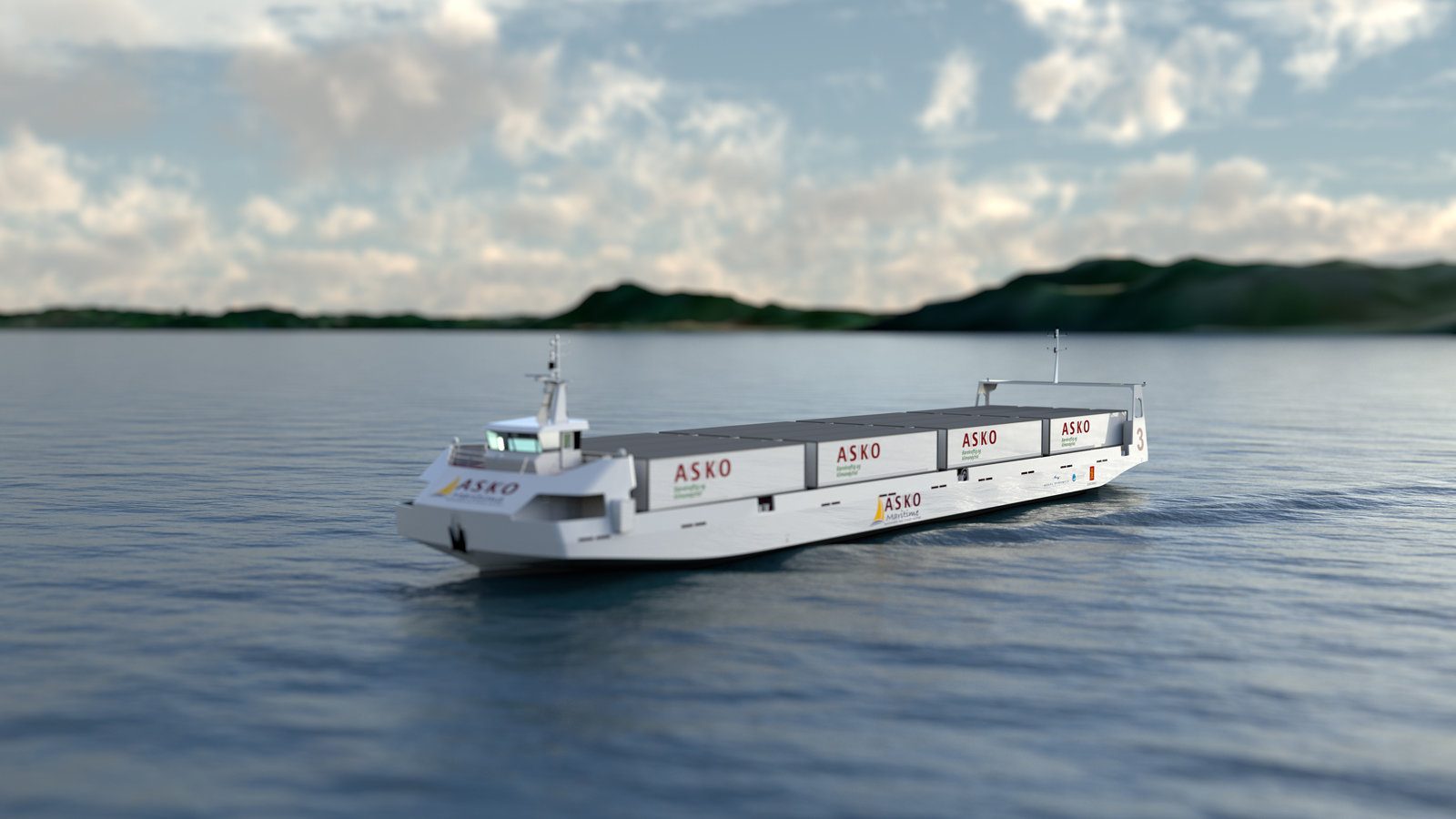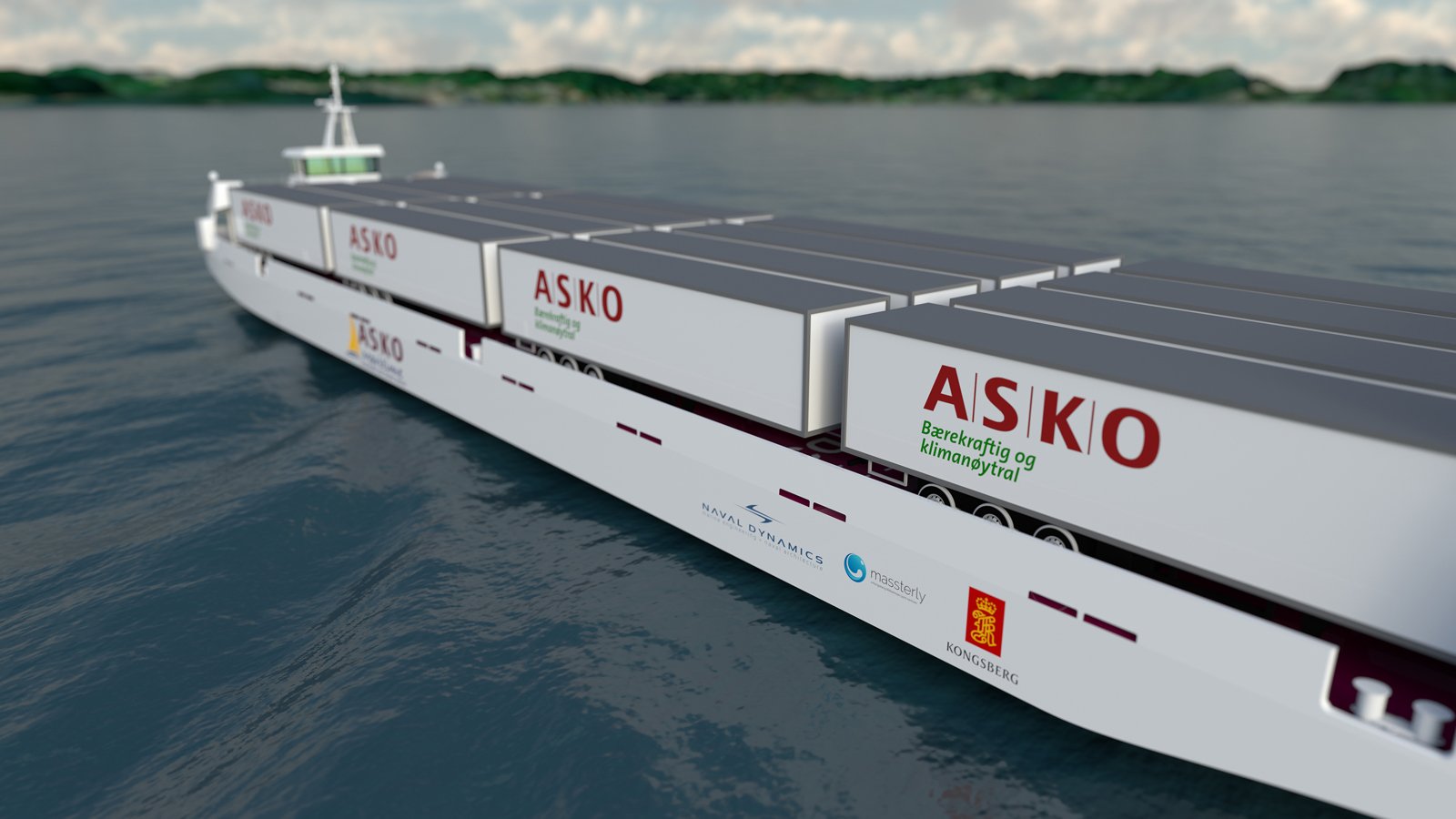
Crossing into new territory
The Norwegian grocery distributor ASKO is committed to efficiency and sustainability in its complex logistics operations. In a collaborative world first, Kongsberg Maritime is playing a vital part in developing new unmanned electric barges to cross a busy fjord in an innovative and low carbon way.
-
Text:Marketing & Communication Department
Photo:KONGSBERG
-
Gunvor Hatling MidtbøVice President, Communications
Getting retail goods onto the shelves of Europe’s supermarkets requires a logistical operation of frightening complexity. With trucks travelling on roads all over the continent, this freight movement is also a major source of carbon emissions.
A pioneering project involving Kongsberg Maritime is set to bring a radical new approach to this issue. In a world first, it will involve Norway’s largest grocery distributor, ASKO, using two newly built autonomous electric vessels to cross the Oslo fjord in order to deliver groceries.
The zero emission vessels, both battery driven, will have the capacity to carry 16 trailers of cargo, each with a maximum capacity of 29 tons. They will reduce road travel by two million kilometres and cut carbon emissions by 5000 tons annually.
The plan is to begin using this new form of transport from the spring of 2022, initially with a reduced crew. During a testing period of about two years, the first of the two vessels will gradually build up its autonomous capability. Approval for fully unmanned operations is expected during 2024.

In this highly collaborative project, Massterly is a joint venture between Kongsberg Maritime and Wilhelmsen.
Both of the vessels, also known as sea drones, will have a permanent bridge for manual operation. However, once the autonomous concept is proved the bridge will be omitted in future builds.
In addition, Kongsberg Maritime will provide the connectivity, using maritime broadband radio (MBR) as well as 4G and, eventually, 5G mobile broadband. The two vessels, both currently being built at the Cochin shipyard in India, will operate a number of round trips each day.
It is expected that the frequency of sailings will increase as the project progresses and the various components are tuned and optimised. The aim is to build the total number up to 150 daily trailer crossings by 2030.
Another KONGSBERG company, Kongsberg Digital, is also involved in the project, having implemented a hydrodynamic and visual simulator model to test and verify sailing routes across the Oslo fjord both westward and eastward in various environmental conditions.
The two vessels are central to ASKO’s passion for sustainability and for driving business efficiency. It currently has a fleet of some 700 trucks and trailers and aims to become carbon neutral in 2026.
The retail giant has already implemented sustainability initiatives including wind and solar based energy production and the introduction of electric and hydrogen trucks. It has set up a new division, ASKO Maritime, to own and supervise the operation of the two vessels.

“The business idea is that we will be a leading player in the development and provider of zero emission sea transport to promote sustainable and innovative logistics solutions.” ASKO Maritime’s CEO, Kai Just Olsen
The aim, he adds, is to establish a fully electric transport chain with electric sea drones, terminal tractors and 50-ton trucks. ASKO has also ordered 75 electric distribution vehicles and charging stations for all its regional warehouses.
“We’re also planning a large-scale project with the goal of zero emissions in all freight traffic in the Østfold region. This is the area connected to the sea drone port on the east side of the Oslo fjord.”
A NEW APPROACH
Kai explains how the operation will work. “Trailers will be transported to and from the ports by electric trucks and port operation will be done using electric terminal tractors. There will be no trucks or drivers on the crossing – that way, they become more productive. The drivers won’t be loading trailers or spending time on sea crossings.
“At present, alternative transport routes involve driving around the Oslo fjord through the city, going through a tunnel or using a ferry connection. None of these contribute to less road traffic, fewer emissions or robust logistics.”
What, though, about the safety of operating unmanned vessels in a busy waterway? He says he sees no problem. “Of course, there are challenges that need to be solved, but it is expected that the vessels will operate on a manned basis for two years. I’m sure that during that time, it can be proved that autonomous vessels can operate at least as safely as manned ones.”
Kongsberg Maritime is developing systems relating to the vessel capabilities, safe and secure connectivity and the Remote Operation Centre, which will be onshore. The architecture will preserve the integrated solution in a cohesive and saleable way.
Key vessel systems are being tested in operation in other environments. The ASKO Maritime sea drones project is seen as an evolution, not a revolution, with those systems simply being used in a different context. However, the onshore aspect is a new area of activity.
The navigational safety of the vessel operation is clearly a priority and processes need to be automated. Sensors will replace the eyes of the captain and a digital version of the crew will be created. Condition monitoring and health management will be of vital importance to be able to monitor the status of the systems and how they are operating.
Technology innovation
The partnerships created through the project are very important. Kongsberg Maritime was an obvious choice for inclusion as it has the competences required and is well aligned with the necessary systems.
One of the main aspects of the company’s contribution to the venture will be in the connectivity between the vessel and the ROC. This will be operating on short crossings close to shore and so will have good broadband coverage, but there still need to be redundant systems.
As there cannot be any mistakes made with an unmanned vessel, maritime broadband radio, a Kongsberg Maritime product, will be the dominant carrier. Wi-fi, 4G and eventually 5G will be deployed as the second carrier for data communications.
The onshore hydrodynamic and visual simulator is already in operation and is being used to verify the routes. This allows the collection of a lot of data before the vessel is built as well as providing the capability to test out its performance and discover just how much energy is required to propel it across the fjord.
It also allows the virtual vessel to be subjected to different weather and traffic scenarios to see how it behaves. This is an integral part of the verification process as it helps to develop the collision avoidance algorithms as well as building confidence.
Few will doubt that the ASKO Maritime project presents a daunting challenge. However, collaboration between the various partners is close and there is a strong collective will to make it happen.
This is largely because the goals are hugely worthwhile. They go beyond proving that the technology can operate on an unmanned basis. The sea drones will also reduce emissions, lead to safer operations, and ultimately alleviate the logistical challenge ASKO is facing with its transportation routes.
Inevitably, Kongsberg Maritime will also learn from participation in this multi-faceted project. It will raise awareness within the company of technical language, the complexity and the understanding and bring a new and necessary focus on integration.
Collaboration has been smoothed and enhanced by the fact that The team at ASKO have been very clear about what they want to achieve and the expectations they have. The relationship is genuinely a joint one.
Kai Just Olsen also sees this partnership approach as being vital. “It’s crucial for the project. Without good collaboration with Kongsberg Maritime and Massterly, it would have been difficult to carry it out. They’ve provided excellent expertise and put together technical solutions that make it feasible.”
ASKO has, he says, further plans to enhance its sustainability credentials and to commission more autonomous sea drones in the future. “The business idea is that ASKO Maritime will be a leading player in the development and provision of zero emission sea transport to provide sustainable and innovative logistics solutions.
“We have emphasised developing a design that will be a standard for future vessels. They can operate as ro-ro or as container vessels. For a longer range, hydrogen-electric can provide an operational alternative.
“We’re excited by the possibilities. Within a competitive transport chain, zero emissions are the goal and achievable. It is important that we in Norway are at the forefront of this and take the opportunity to develop technology solutions that contribute to sustainable logistics.
“Projects like this one are at the forefront and will provide excellent export opportunities for technology, regulations and expertise that need to be used widely in the future,” he says.
The sea drones project is part of a proposed fully electric transport chain with other assets including electric terminal tractors and trucks. The plan also includes automatic mooring, charging and ferry bridges.
ASKO’s future plans include warehouses on both sides of the Oslo fjord in an area experiencing growing industrial and warehousing activity. Using autonomous sea drones to cross this stretch of water will cut emissions and remove vehicles from roads that are currently heavily used.
The company aims to co-operate with other transport companies and industries, and public authorities, in order to maximise the reductions in emissions.
Once the concept of using unmanned electric sea drones has been proved, there is significant potential to roll this pioneering model of transport out into other areas and ports. Future vessels could use hydrogen-electric power in order to extend their operating range.
https://www.norgesgruppen.no/norgesgruppen-in-english/this-is-norgesgruppen/